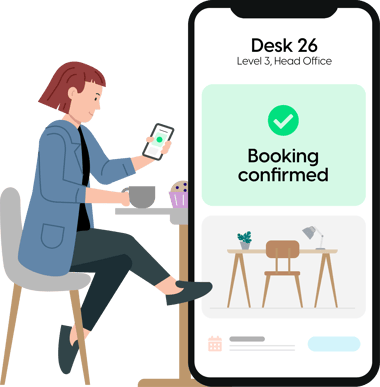Optimizing Spaces Through Smart Office Space Management

In recent years, the concept of the traditional office has undergone a substantial shift. The rise of remote work, flexible schedules, and collaborative work environments has changed the way office space management is approached.
Many businesses have implemented a hybrid work model to cater to changing employee needs, allowing employees to be in the office a few days each week rather than sticking to the traditional five-day schedule. However, this change comes with several challenges.
Many leaders have realized that their office space does not cater to these new expectations, as they are too rigid and mismanaged. As a result, many offices and desks remain empty or unused, collaboration suffers, and office overhead remains costly.
As businesses look to create productive, engaging, and efficient workspaces, smart office space management has become very important. More than ever, having a clear vision of your office space while creating a positive experience is expected and required.
In this article, we'll look at the basics of workspace management: the fundamentals, its significance in enhancing employee experience, and how leveraging technology can take your workspace to the next level.
What Does Office Space Management Mean?
Office space management is the planning, organization, and utilization of physical workspaces. It involves making decisions about how spaces are used and maintained to foster a productive and comfortable work environment.
So, what does that mean for leaders and companies? Effective office space management entails a few things, including:
- Layout design
- Resource allocation
- Technology integration
Layout design refers to the arrangement and organization of physical spaces, objects, furniture, and other elements within an environment. In short, it means strategically placing these elements to improve functionality, flow, and aesthetics.
When it comes to office spaces, layout design means planning how different areas, workstations, meeting rooms, and communal spaces are positioned. The goal of the design is to ensure that the arrangement of these elements supports your objectives.
Resource allocation means using the resources available in a workplace to make things work better, be more productive, and be more cost-effective. That includes making decisions about how to assign components such as physical space, furniture, equipment, amenities, and utilities to meet the needs of employees and the business as a whole.
Technology integration means using leading software and digital tech tools to enhance your workplace, leveraging technology to streamline various aspects of managing the physical workspace, from desk assignments and room reservations to optimizing use of amenities and resources.
The Increasing Importance of Workspace Management
Efficient office space management will help a business in several ways. First, it results in significant cost savings. By maximizing the use of existing office areas, businesses can avoid unnecessary expenses related to additional square footage.
Also, a well-managed workspace can contribute to improved employee satisfaction and engagement. An organized and purposeful environment can positively impact the overall employee experience, increasing productivity and reducing turnover rates.
Finally, workspace management saves time by ensuring employees have the right resources, organized spaces, and easy access to information. It also enables smoother workflows, quicker task completion, and more productivity.
The Best Practices for Effective Office Space Management
To achieve success, adopting effective office space management best practices are crucial. Here are some to include in your plans:
- Conduct regular space audits to assess how they are being used.
- Optimize your designs to encourage collaboration and communication.
- Implement flexible workspace solutions that accommodate diverse work styles.
- Create designated areas for focused work, brainstorming sessions, and relaxation to enhance the overall work experience for employees.
You can also gain inspiration from other office spaces in your industry. Take a look at social media, company websites, and other online resources to see what is working well for others.
Harnessing Technology for Smart Workplace Space Management
More than ever, technology plays a pivotal role in enhancing office space management. One option is SwipedOn's space management solution, a leading workspace management software that manages all your resources from one place. This software simplifies desk booking and provides real-time insights so you can see how the spaces in your workplace are being used.

With SwipedOn space management software, employees can seamlessly reserve desks, vehicles, car parks and more, ensuring that your space is being utilized efficiently and transparently.
Many businesses love this technology because it frees up their admin teams, saving time and money. For example, by using the SwipedOn Pocket app, staff can book what they need from anywhere, simplifying logistics.
Need a coworking space manager? SwipedOn can help.
SwipedOn is full of features that you’re sure to find useful. Here are just a few that customers rave about:
- Zones allow you to group resources and define who can book in that zone to create better collaboration.
- Auto release keeps popular resources in use by automatically freeing up resources that haven’t been checked out by a certain time.
- Interactive maps help staff find what they need fast with real-time resource availability, the ability to edit floor plans, and more.
As the workplace continues to evolve, business leaders are gaining more appreciation for effective office space management. From cost and time savings to improved employee satisfaction and engagement, the benefits can have a big impact.
By leveraging solutions like SwipeOn’s space management software, your business can harness technology to create agile, flexible, and dynamic work environments, which helps foster collaboration, innovation, and growth.
As you embrace the future of work, space management should remain a focus for your business. SwipedOn helps over 9,000 workplaces navigate these changes, and we’re here to help you. Try it for FREE today with a 14-day trial.









 Germany - Deutsch
Germany - Deutsch